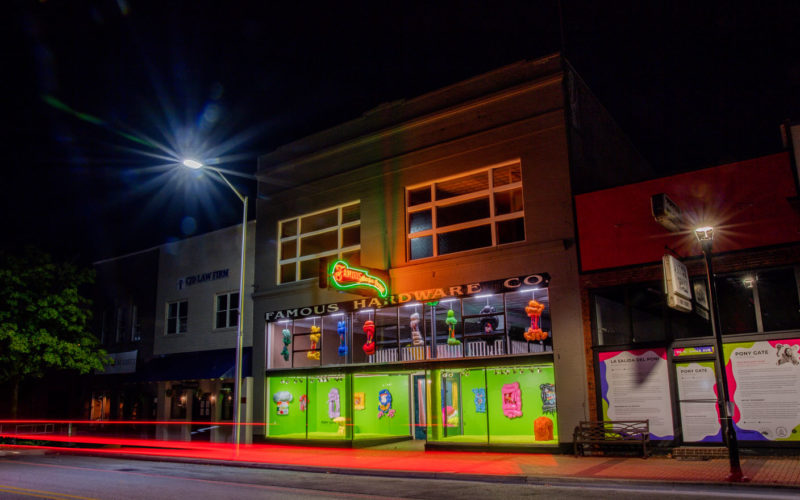April Wallace
awallace@nwaonline.com
While doing an artist’s residency in upstate New York, Amelia Briggs went driving around one day and spotted something that has stuck in her mind ever since.
It was a pony gate, a literal entrance to a horse ranch that was made out of wood. Despite being worn down from the weather and age, its pastel colors were still vibrant.
“It was really weird … really elaborate, so ridiculous,” says Briggs. “I immediately came up with ‘pony gate’ and became interested in the phrase.”
Ponies, of course, are real, but our culture often means talking about them in a way as if they aren’t. Briggs liked the idea of toying with that dichotomy in a work of art.
“They seem mystical, like a joke, and it fits really well,” Briggs says.
She didn’t have a way to take a photo the day that she spotted her inspiration, but it turns out she didn’t need one after all. When she was accepted as the next artist to make an installation for the Famous Hardware building in downtown Springdale, commissioned by Creative Arkansas Community Hub and Exchange, Briggs knew she had exactly the thing for the unique space. Through a grouping of her old works and some of her new, Briggs would create an experience like the one she had in New York.
“Pony Gate” is currently on display and will be in place through the end of November. Briggs gave an artist talk last week in Springdale.
“Thinking about the space (of Famous Hardware), it’s like it has two pillars in the front, covered in fur, like a gate,” Briggs says. “You try to enter, but you can’t.”
She likens it to the way that you can’t ever really, fully know a person. You can explore and discover many things, but the internal is trickier, holds more mystery. Viewers of the exhibit can see a number of her abstract works in the windows of Famous Hardware, displayed on now-neon green walls, nestled above neon green carpet. Briggs is fascinated by the space, which she says lends itself to creating dioramas.
Many of the artworks have odd shapes, a bit of sheen, or frames of fur. A couple of them are stand-alone pieces, one of which looks a bit mushroom like. If you peek into the front door, all you can see is a rainbow of satiny materials—“fun, colorful fabrics.”
“It’s rare to find a place, manipulate a space like painting the walls, not all galleries are cool with that,” Briggs says. Her work, composed of sewn, reclaimed fabrics, fiber oil and latex, has been shown in London, Paris and Florence, among other locales.
She finds that her works are best received when she can manipulate the space like this, rather than being stuck with a white cube to showcase her pieces.
“The opportunity to play a lot with creating this environment is ideal in terms of my work. Any time I show, I like to create an environment … and play off the colors and textures around.”
Briggs began as a more traditional oil painter who was interested in the body, but as her work and interests grew, that morphed into incorporating elements that felt “cartoony.” She began manipulating her canvases to make them more closely resemble objects. Now she uses mostly reclaimed materials from thrift stores, like bedsheets or materials dense enough to hold up to coatings of latex and paint.
After some years of bartending and working in distributing, Briggs knew she had to get back into art making. She saved her money, spent six months doing only that, and then attended graduate school before working as a director of a contemporary art gallery.
Sharing works on Instagram became a useful tool to keep her fixed to her process.
“I used it as seriously as I could, to hold me accountable,” Briggs says. “I would post my progress as a way to feel like I was involved in the art community.”
After Briggs built up a following, she began to get more opportunities like displaying in galleries abroad. Instagram was a tool for telling her story through art and connecting with other artists, enabling them to share their works with each other.
Also adding to her rise as a full-time artist was her hobby of making custom mirrors with unique borders, in conjunction with designers, which many folks bought from her throughout the pandemic. One is on display in “Pony Gate.”
“I talked to a lot of artists who became full time during the pandemic,” Briggs says, noting that it might not be what you expect. “A lot of people were spending more time online, trapped in their house, and were starting to think about how they wanted things (to look) in their home, and started buying more art. Like ‘I want something more interesting.’”
She doesn’t like to give away much about what she thinks her artworks should bring to mind, though she admits some are more figure-like than others and that the “weird environments” might feel uncanny and familiar to any child of the ’90s. Cartoons were influential to her and made an impact on what she was interested in creating visually.
“I like it to be this unknowability, and the viewer will bring to it whatever recognition they might find in the work,” she says. The theme of the exhibit is a bit based in the lasting influences of childhood.
“Some may feel like characters. There’s a certain interior process rooted in identity to how we become who we are and what aspects of childhood play a role in how we see the world. There’s vulnerability from those experiences.”
__
FAQ
‘Pony Gate’
WHEN — Through the end of November
WHERE — Famous Hardware Building, 113 W. Emma Ave. in Springdale
COST — Free
INFO — downtownspringdale.org



